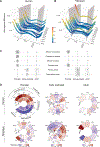Spatiotemporal transcriptomic divergence across human and macaque brain development
- PMID: 30545855
- PMCID: PMC6900982
- DOI: 10.1126/science.aat8077
Spatiotemporal transcriptomic divergence across human and macaque brain development
Abstract
Human nervous system development is an intricate and protracted process that requires precise spatiotemporal transcriptional regulation. We generated tissue-level and single-cell transcriptomic data from up to 16 brain regions covering prenatal and postnatal rhesus macaque development. Integrative analysis with complementary human data revealed that global intraspecies (ontogenetic) and interspecies (phylogenetic) regional transcriptomic differences exhibit concerted cup-shaped patterns, with a late fetal-to-infancy (perinatal) convergence. Prenatal neocortical transcriptomic patterns revealed transient topographic gradients, whereas postnatal patterns largely reflected functional hierarchy. Genes exhibiting heterotopic and heterochronic divergence included those transiently enriched in the prenatal prefrontal cortex or linked to autism spectrum disorder and schizophrenia. Our findings shed light on transcriptomic programs underlying the evolution of human brain development and the pathogenesis of neuropsychiatric disorders.
Copyright © 2018 The Authors, some rights reserved; exclusive licensee American Association for the Advancement of Science. No claim to original U.S. Government Works.
Conflict of interest statement
Figures







References
-
- Montagu MFA, Time, Morphology, and Neoteny in the Evolution of Man. Am. Anthropol. 57, 13–27 (1955).
-
- Prechtl HF, New perspectives in early human development. European journal of obstetrics, gynecology, and reproductive biology 21, 347–355 (1986). - PubMed
-
- Bogin B, Evolutionary perspective on human growth. Annu. Rev. Anthropol. 28, 109–153 (1999). - PubMed
-
- Schultz AH, Age changes in primates and their modification in man. J. M. Tanner, Ed., Growth Human (Pergamon Press, Oxford, 2009).
Publication types
MeSH terms
Grants and funding
- R01 MH110928/MH/NIMH NIH HHS/United States
- R01 MH094714/MH/NIMH NIH HHS/United States
- U01 MH103365/MH/NIMH NIH HHS/United States
- R01 MH110927/MH/NIMH NIH HHS/United States
- S10 OD018521/OD/NIH HHS/United States
- U01 MH103392/MH/NIMH NIH HHS/United States
- R01 MH109677/MH/NIMH NIH HHS/United States
- U01 MH103346/MH/NIMH NIH HHS/United States
- U01 MH103339/MH/NIMH NIH HHS/United States
- R01 MH110920/MH/NIMH NIH HHS/United States
- R01 MH109904/MH/NIMH NIH HHS/United States
- R01 MH110921/MH/NIMH NIH HHS/United States
- U01 MH106874/MH/NIMH NIH HHS/United States
- R01 MH110926/MH/NIMH NIH HHS/United States
- P50 MH106934/MH/NIMH NIH HHS/United States
- I01 BX002876/BX/BLRD VA/United States
- R21 MH103877/MH/NIMH NIH HHS/United States
- R01 MH113257/MH/NIMH NIH HHS/United States
- R01 MH110905/MH/NIMH NIH HHS/United States
- HHMI/Howard Hughes Medical Institute/United States
- R21 MH109956/MH/NIMH NIH HHS/United States
- R01 MH111721/MH/NIMH NIH HHS/United States
- U01 MH103340/MH/NIMH NIH HHS/United States
- R21 MH102791/MH/NIMH NIH HHS/United States
- R01 MH105898/MH/NIMH NIH HHS/United States
- R21 MH105881/MH/NIMH NIH HHS/United States
- S10 OD030363/OD/NIH HHS/United States
- R21 MH105853/MH/NIMH NIH HHS/United States
- R01 MH109715/MH/NIMH NIH HHS/United States
LinkOut - more resources
Full Text Sources
Other Literature Sources
Medical

